It’s still 25 to 30 degrees, no more Meltemi and almost no more tourists. The blues of the Aegean and the Cycladic houses are as enchanting as ever, and cruising with small children safer. We embark for a week at the Sunsail base in Athens on Unpectable, “invincible”, an Oceanis 46.1 in absolute comfort.
Text: Camille Gonzales
Photos: Yoann Lelievre
The numerous islands, some twenty miles apart, offer a vast playground and multiple itineraries depending on weather conditions. The crew is made up of two young sailors, aged 3 and 7, and their parents. We arrive in Athens on the eve of departure to do a little sightseeing, as the big sailor says he’s been fascinated by ancient Greece “since I was a child”. We were delighted to explore the Acropolis museum, and the Plaka and Anafiotika districts at the foot of the sanctuary, whose narrow, colorful streets foreshadowed the rest of our trip to the Cyclades. We take possession of the boat the next day. The final weather check confirms our plans: we start with a long 40-mile sail towards the island of Kythnos and its mythical anchorages of Ormos Kolona and Ormos Fikiadha. Two deep coves separated by a tongue of fine sand, formidably sheltered from all winds, and hiding hot springs.
Heading south
We cast off early on Sunday morning, while the children were still asleep. The first few miles, into the wind, pass by under engine. Near the island of Flèves, along the Attica peninsula, the wind smiles on us, and a slight rocking motion allows us to hoist the sails and head for the finish upwind. The children moor up, get their bearings on the boat and watch, transfixed, as the huge cargo ships pass by on their way from Piraeus to Izmir in Turkey. The temple of Poseidon, majestically overlooking Cape Sounion, the southernmost tip of Attica, is reached by mid-day. The island of Kea soon marks our entry into the Cyclades and sets the tone: arid, rocky, almost desert-like landscapes, punctuated by craggy mountains and cliffs. Shortly before 4 p.m., Kythnos stands in our way, and we enter a timeless place of wonder. We launch the dinghy to explore the bay. You’d expect the place to be crowded in summer, but at this time of year there are only six of us at anchor. On land, it’s deserted, except for two houses and a magnificent bar-restaurant reminiscent of the film The Big Blue. First Cycladic aperitif. Our eldest son makes friends with a Greek child of the same age. Language difference is no barrier when you speak the universal language of children. It’s so beautiful that we’d love to stay all week, but we have to move on to discover other wonders.
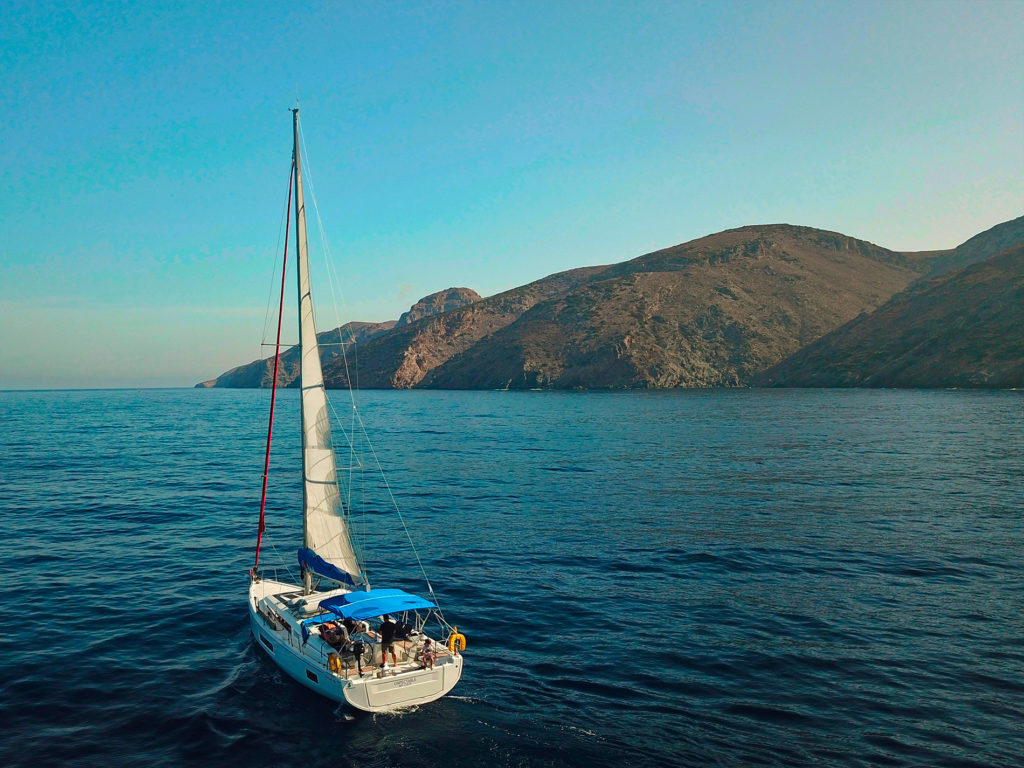
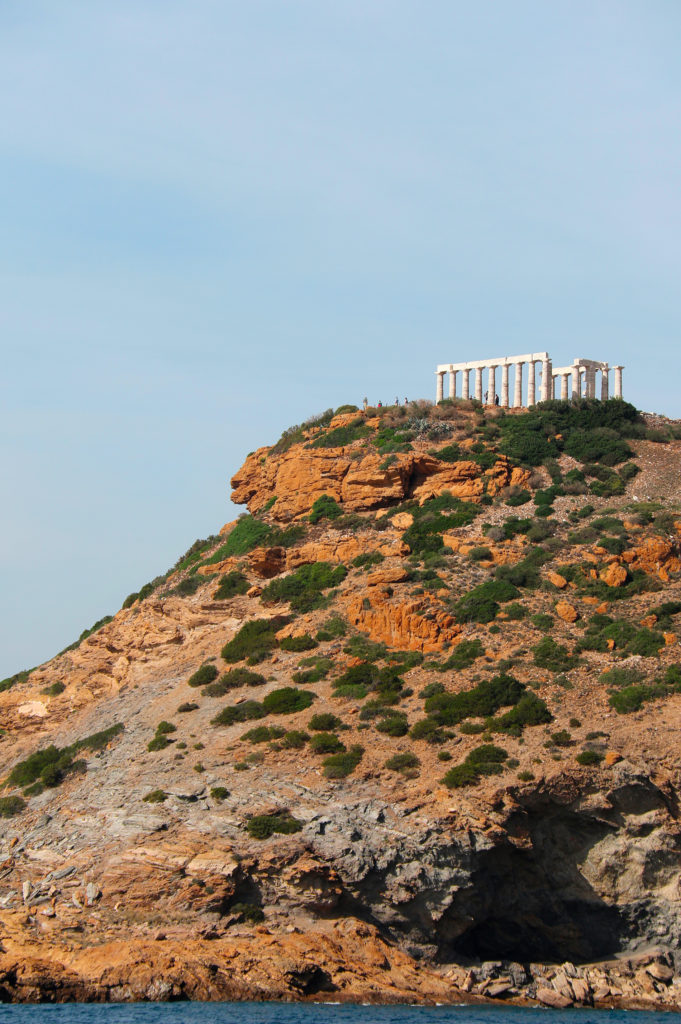
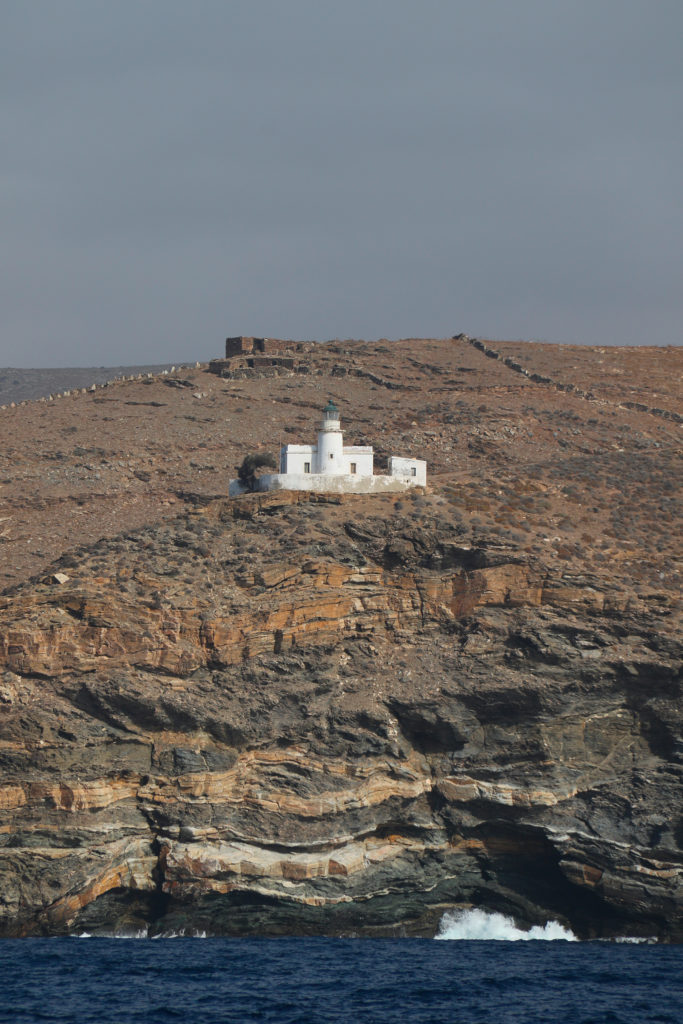
Syros, the capital
We continue our journey to the island of Syros, administrative center and capital of the Cyclades, which saw major commercial and cultural developments in the 19th century. Ermopoulis, the island’s main town, was the site of Greece’s first hospital, the first high school and the first modern shipyard. The area also saw the rise of the textile, steel, tanning and soap industries, as well as the banking and insurance markets, before going into economic decline after the Second World War. Tourism brought the island back to life at the end of the 20th century, its rich history making it a special place in the Cyclades, with a remarkable neoclassical architectural heritage, both in Ermopoulis and in the bay of Foinikas, where we are visiting.
The weather forecast calls for a light southeasterly wind, so we can look forward to some fine sailing, downwind along Kythnos and then abeam to Syros. 27 miles to go. The weather is fine and warm. We skirt Kythnos to admire its north coast one last time, a splendid succession of small mountains interspersed with narrow canyon-like valleys. We soon reach the tip of the island and catch a glimpse of the town of Loutra, where we’ll probably stop on the way back. The wind gradually dies away, and in the distance we can make out sea entrances, the density of which we can only guess at when we suddenly see a ferry appear out of nowhere. 20 minutes later we enter the thick fog at 5 knots from the east.
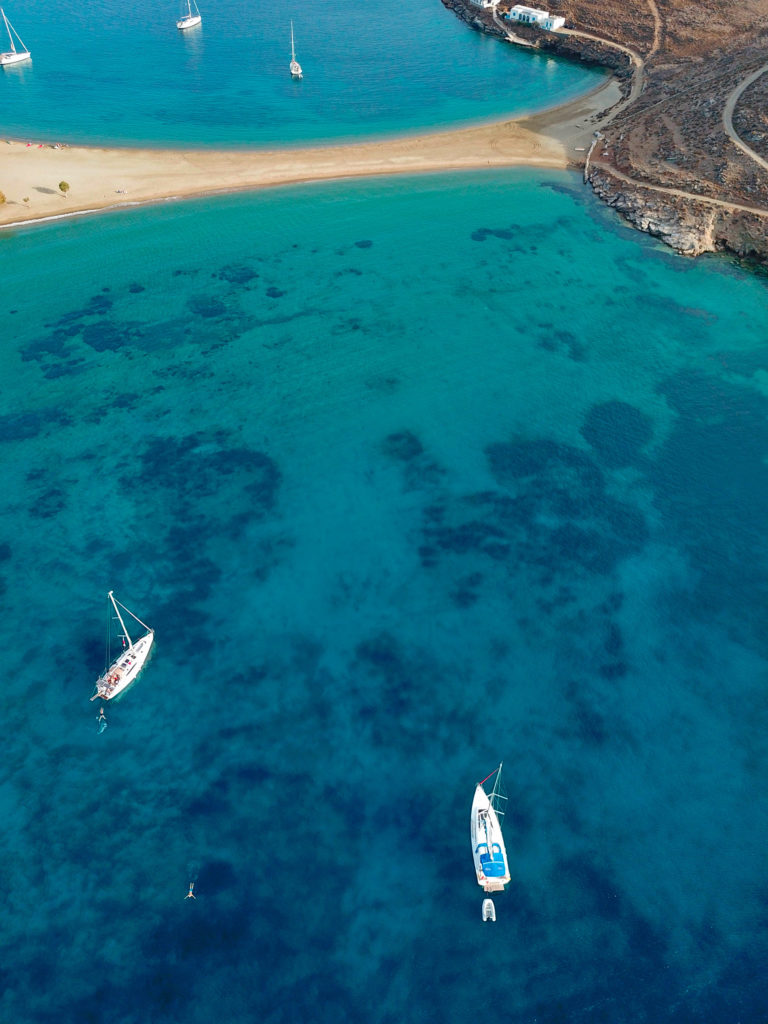
Radical change of atmosphere. All hands on deck, vests on, foghorn in hand, ears cocked to the VHF, eyes scanning the white and the phone screen for the AIS position of the boats around us. You can’t see for 10 meters, and the area is a busy thoroughfare for ferries and freighters. All our senses are called upon to avoid a collision. Some two long hours later, we emerge from the fog and finally catch sight of Syros, glistening in the sunlight, 10 miles ahead. This phenomenon is well known in the Mediterranean, and results from the meeting of a mass of moisture-laden air with a mass of warm air. A word of advice: in addition to taking the usual precautions in such situations, use technology to your advantage and track live satellite images to find out how fast the clouds are moving (e.g. meteoblues or the local weather service: poseidon.hcmr ), as well as the AIS positions of boats on mobile applications that also geolocate you (e.g. Marine Traffic). The mobile network is excellent, even offshore between the islands. We arrive at the small port of Foinikas at around 3 pm. Square white houses with blue shutters tower over us from above as we enter the bay. The water is clear and the weather warm. The wind turns northerly tomorrow, which will be perfect for getting down to Serifos.
In a jewel box in Serifos
Often referred to as the “pearl of the Cyclades” in guidebooks, Serifos is renowned for its many beaches – some of which are adorned with white sand and turquoise water – and its capital, Chora, a medieval town overlooking Livadi Bay, where we are stopping. Built amphitheatrically on a rocky spur for protection from pirates, it is one of the most beautiful villages in the Cyclades. We decide to stay two nights in Serifos and rent a car to visit the island and explore Chora. The houses here are intertwined along narrow streets paved with staircases. Everything’s closed at this time of year, so we’re practically on our own. The climb is a succession of delights, culminating in a breathtaking panorama on the forecourt of the church of Agios Constantinos. We continue our tour of the island by car, then return to the boat for a lazy late afternoon punctuated by naps, card games and angling.
Loutra’s unusual Jacuzzi
Since the beginning of the week, the weather forecast has been formal, predicting 20 knots of SW’ly for the fifth day of the voyage. This is the ideal time to set a northerly course for Athens in three 20-mile legs. This was the pace we decided from the outset was the most appropriate for small children. It allows us to leave in the morning around 9 or 10 a.m. and arrive at the next point around 2 or 3 p.m., offering reasonable sailing times and the opportunity to discover the islands. We set course for Loutra, north-east of Kythnos, whose harbour is ideally sheltered from southerly winds. Overcast skies and a regatta atmosphere as we set sail from Serifos, where we knit together with three other boats for a few gybes before splitting up. It was the best sailing of the week. The boat glides beautifully downwind. The miles flew by at an average of 9 knots, and we were lucky enough to see some dolphins. Four hours later, we entered the deep bay of Loutra and docked with the help of our port neighbors. The lace-like coasts of the Cycladic islands offer plenty of shelter for sailors. Loutra is no exception, and if its small port is full, you’ll find two more beautiful coves to anchor in. As soon as we arrived, it was time to put on our swimsuits and try out Loutra’s famous natural spa: a small jaccuzi surrounded by stones, which collects the warm waters flowing down to the beach. On our return, the entire fleet of cruisers enjoy the spectacle of cats massing on the quayside, waiting with open jaws for the suicidal leap of poor sardines obviously fleeing underwater predators. The summer evening continues in a charming restaurant occupied only by us. One of the prettiest memories of the trip.

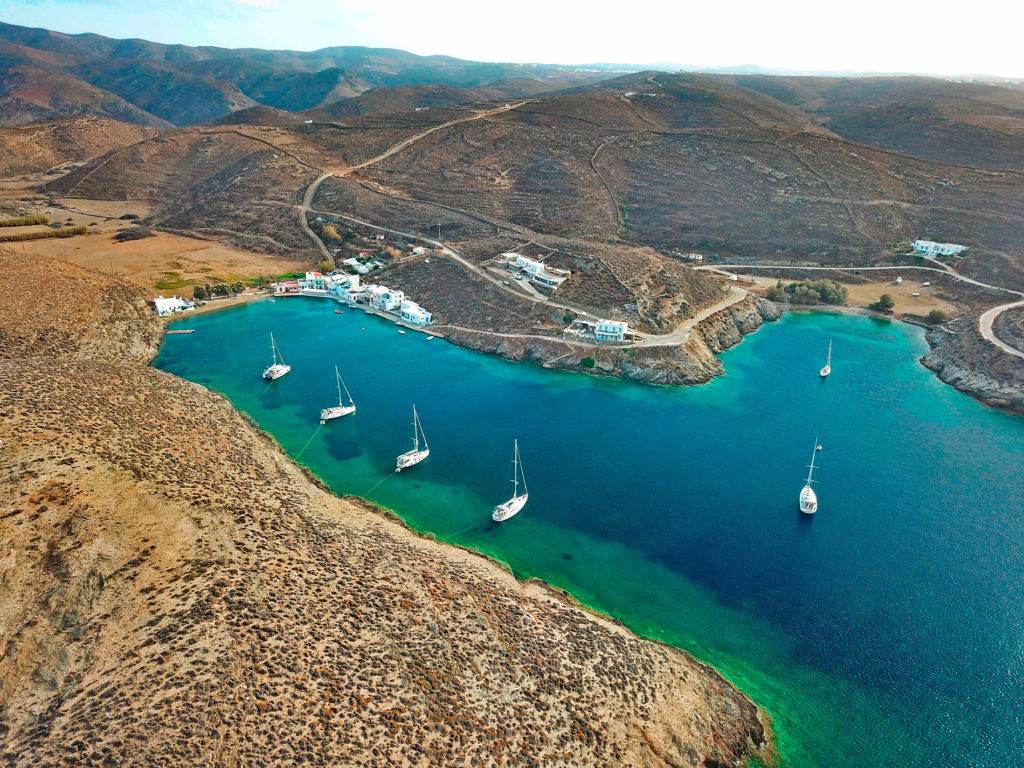
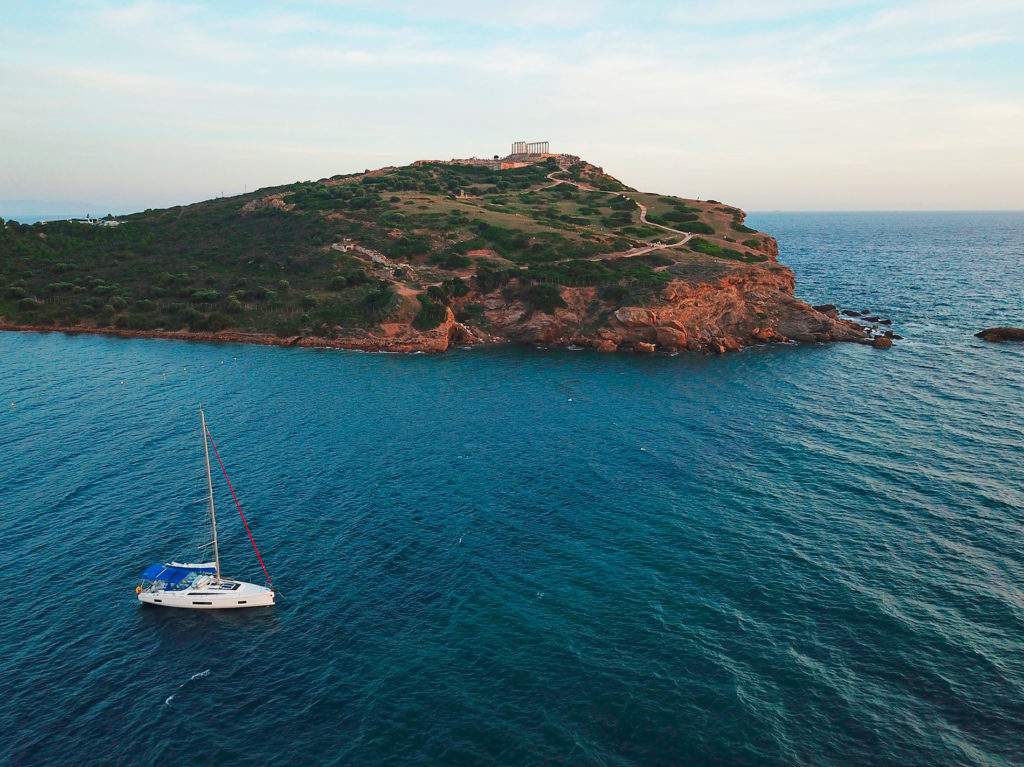
Sounion
It’s time to head for the mainland for a final night at anchor at Cape Sounion. The weather is fine again, with a light south-westerly wind. The sea sparkles and we leave the Cyclades in our wake. Once we reach Sounion, the landscape changes. The vegetation returns and the coast is decked out in red ochre and green. This last anchorage gives us the opportunity to visit the Temple of Poseidon after a swim in water still at 25 degrees. Built in the 5th century BC, the building is still in very good condition and impresses with its stature. We enjoy a magnificent sunset and fall asleep under the glow of the full moon and the magnificently lit temple. Tomorrow it’s back to Athens.
The trip left a lasting impression on the children, who unknowingly learned a little about navigation, geography and ancient history. For the whole family, the cruise extended summer into the last moments of autumn, as our “home port”, Geneva, entered winter. In our experience, spring and autumn are certainly the best times to visit Greece, which is now experiencing summer temperatures approaching 50 degrees and a tourist flow that is discouraging for anyone who doesn’t like crowds.
Practical info

Sunsail base
Sunsail’s Athens base is located at Marina Zéa in Piraeus. This marina welcomes mega-yachts from all over the world, and is a bustling port both day and night. To reach the marina, it’s best to arrange a transfer from the airport. The airport is around 45 km from Athens, and can be a long way by bus or metro. Sunsail offers you a local supermarket with supplies delivered directly to the boat. Take a few days to enjoy the city and its historic monuments. The Acropolis and its museum are very busy, but these historic sites are well worth a visit.
To organize your customized trip and/or navigation
Simone évasion, info@simone-evasion.ch, simone-evasion.ch. Or Voile Évasion, fabienne@voile-evasion.ch, voile-evasion.ch.
From Athens
From Piraeus, you have two options for your sailing. The first is the Saronic Islands, southwest of Athens. This sailing area is well sheltered from strong winds, making it the perfect destination for a peaceful cruise. Second option: the Cyclades. With its white and blue houses, the Cyclades are a picture-postcard setting. To make the most of the many islands, allow two weeks. Indeed, depending on the weather conditions encountered, one week may seem a little short. Please note that in the Cyclades, all restaurants and shops close at the end of October for the winter. One night’s accommodation in a port will cost you between €10 and €20.
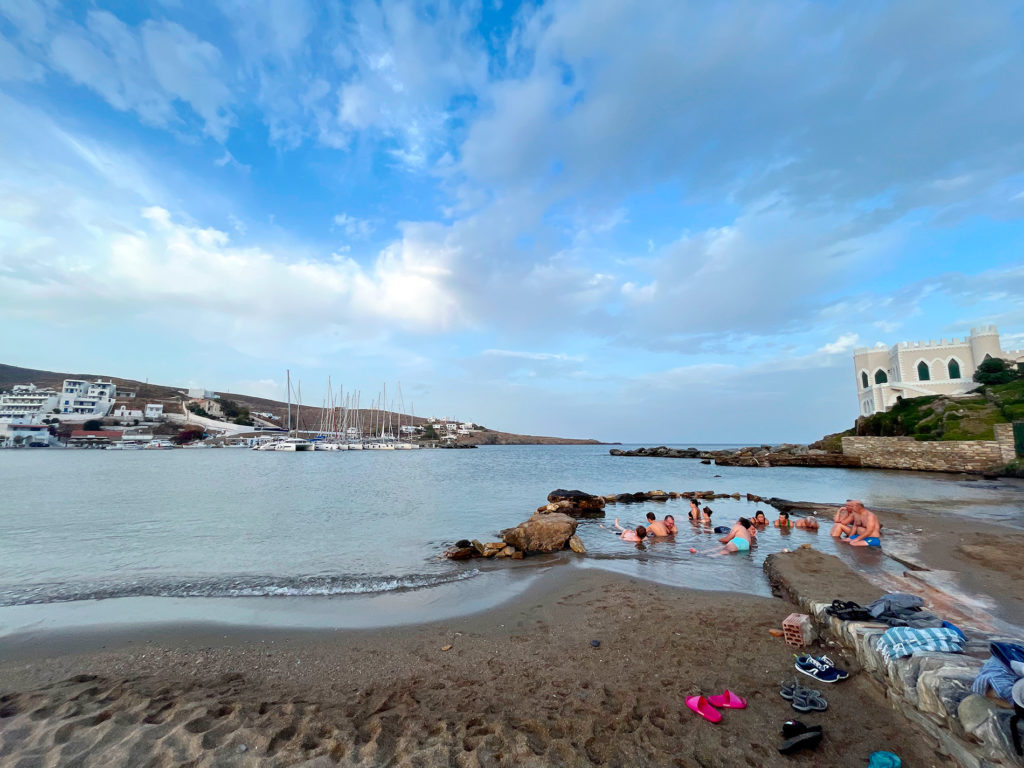

Useful websites
Sunsail, to charter your sailboat: sunsail.com
Navilly is a very practical website for moorings, regularly updated by users, and very complete: navily.com
For local weather: poseidon.hcmr.gr
The MarineTraffic application available on App store and Play store is very useful for locating cargo ships and ferries. There’s a lot of shipping traffic near Athens, and it helps you anticipate their trajectory: marinetraffic.com

